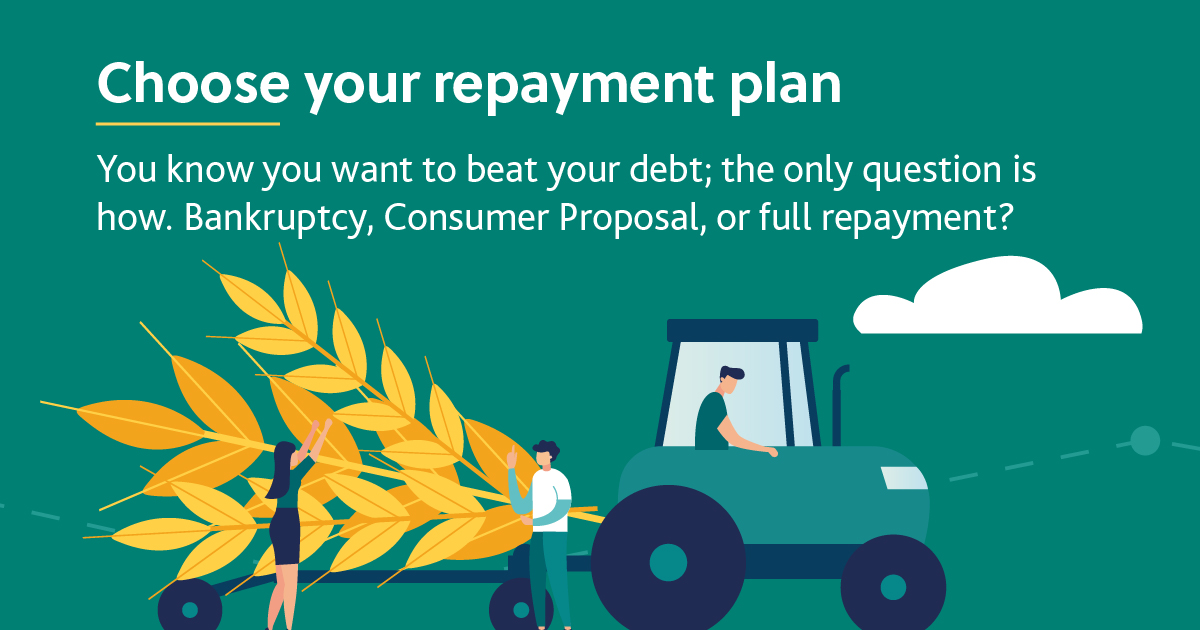If you’ve spent time reviewing your financial situation, then you’re ready to take the next step in your journey towards freedom. In the best-case scenario, you can outline a strategy to fully pay off your debts. Financial advisors can help you prioritize your debt repayments based on due dates and interest rates. However, your research may reveal that you are unable to pay off your debts. You’re likely faced with two options: filing for Bankruptcy or filing a Consumer Proposal.
Entering this stage of your journey can be scary. A lot of people are concerned about the stigma that comes with something like Bankruptcy. The good news is that even though there are real-life consequences to your financial state, these filings can ultimately just be a step on your journey to financial well-being.
Option #1 — Bankruptcy
Filing for Bankruptcy means that you are entering a legal process that will erase your debts, giving you a fresh start. You will be required to work with a Licensed Insolvency Trustee (LIT), an expert who will oversee the process, fulfill the paperwork requirements, and generally serve as your guide through your financial journey.
Your LIT will also help to file tax returns throughout the process and will need to monitor your income throughout the filing. Any assets you have will be subject to your Bankruptcy filing. Your LIT will work with you to identify which assets are exempt pursuant to your Provincial Legislation, such as your vehicle, and other personal or household items.
By the time your Bankruptcy is finished, you will no longer be liable for your debts. There are some exceptions like student loans in certain situations, or child support, but you will be put in a position to move forward in your life with a more manageable financial foundation.
Continue doing your own research on Bankruptcy to get more information and answer additional questions about the process.
Option #2 — Consumer Proposal
Filing a Consumer Proposal is an opportunity to negotiate to repay a portion of your debt over five years at the most. This is also a legal process that requires the support of a Licensed Insolvency Trustee. Your LIT will work with you to ask creditors to take a reduced repayment amount for an agreed upon lump sum or monthly payment.
Your LIT will use their expertise to evaluate your finances and prepare a proposal with reasonable payment amounts and repayment period. This proposal will be submitted to your creditors who have 45 days to vote on accepting it. The creditor's voting power is determined by the amount of money owed to them. In the case the proposal is not accepted, you and your LIT will have the opportunity to make changes and negotiate further with the creditors. If the majority of the creditors vote to accept your Consumer Proposal, it will become legally binding on all creditors.
Throughout your repayment period, you will make payments directly to your LIT who will distribute the money to your creditors as per your proposal terms. In most cases, you will be able to retain your assets and this would be built into your proposal. In other words, you’ll have to continue with payments on a home or vehicle throughout the proposal in order to retain those assets.
For more information, refer to MNP’s Consumer Proposal guide.
The Key differences between Bankruptcy and a Consumer Proposal
Bankruptcy and Consumer Proposals do have some things in common. They are both debt solutions that can only be administered by your LIT. They offer a legal framework to get out of debt while making sure that collectors stop collection calls and garnishing your wages. And they are both a means to move on from your debt.
The differences between Bankruptcy and a Consumer Proposal are far more important when it comes to reviewing your options. Here are five key differences to consider.
#1 — Credit rating
Bankruptcy: Your credit rating will be affected for six years after you have completed your Bankruptcy
Consumer Proposal: Your credit will be affected for the time you are in the proposal plus three years after to a maximum of six years
#2 — Assets
Bankruptcy: Non-exempt assets are subject to seizure
Consumer Proposal: Your assets are protected in a proposal
#3 — Income and expense reporting
Bankruptcy: Monthly income and expense reports must be submitted to your LIT
Consumer Proposal: No requirement for monthly income and expense reporting
#4 — Successful filing
Bankruptcy: Creditors cannot refuse a Bankruptcy filing
Consumer Proposal: Creditors can vote against your proposal
#5 — Debt amount
Bankruptcy: There is no limit to the debt owed to file for Bankruptcy
Consumer Proposal: You cannot file a Consumer Proposal if you owe more than the maximum amount of $250,000 (not including a mortgage on a personal residence).
There are several other pros and cons to both Bankruptcy and a Consumer Proposal. For more information on the differences between them and what option is best for you, review MNP’s Frequently asked questions about debt.
A Licensed Insolvency Trustee for debt freedom
The most common factor in filing for Bankruptcy or Consumer Proposal — aside from taking a step toward debt freedom — is the need for a Licensed Insolvency Trustee. But you don’t have to wait until you’ve decided what to do before contacting LIT, they can work with you to assess your financial health and help you decide which option is best for you. At any point in your journey, an advisor will support you in making the best choice for your future.
Bankruptcy and Consumer Proposals are both significant steps to take in your journey. With their hard work, expertise, and judgment-free approach, Licensed Insolvency Trustees can make the process just a little bit easier.
Next Blog: Part 4: Visiting a local trustee – why being local matters



